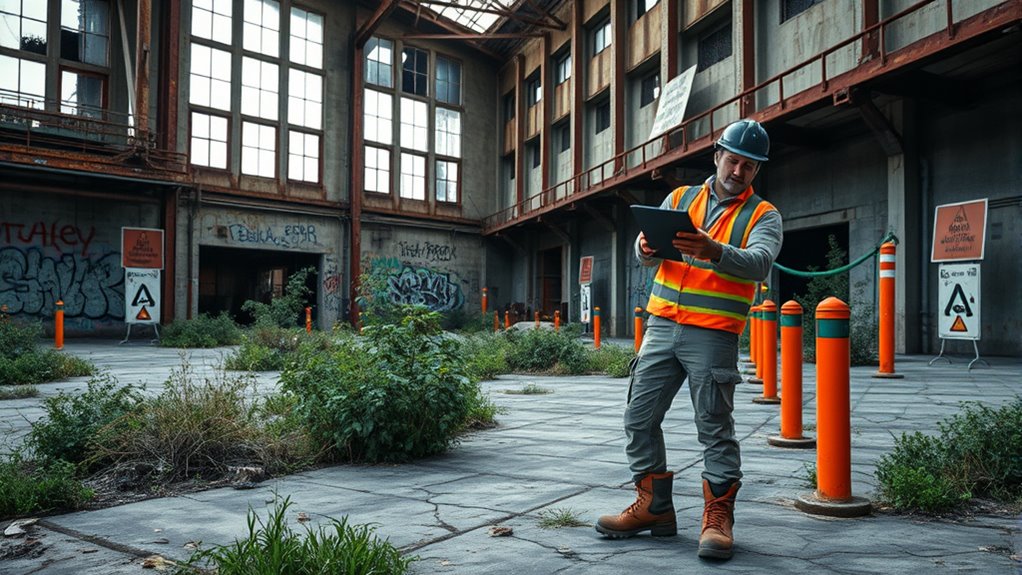To guarantee safety at abandoned sites, you start with a thorough hazard assessment to identify risks like unstable structures or toxic materials. You implement strict access controls with barriers, signs, and authorized check-ins to keep untrained individuals out. Before entering, you verify safety gear and brief everyone on hazards. Throughout your work, you continuously monitor for new dangers and adjust safety measures accordingly. Keep going to discover more key safety steps for these challenging environments.
Key Takeaways
- Conduct comprehensive hazard assessments to identify structural, environmental, and chemical dangers before site entry.
- Implement strict access controls using barriers, signage, and authorized check-in systems to prevent unauthorized entry.
- Prepare all personnel with safety equipment and briefings on site-specific hazards and protocols.
- Regularly monitor the site for new hazards or condition changes, updating safety measures accordingly.
- Document all safety procedures and assessments to ensure consistent safety practices and compliance.

Abandoned sites pose significant safety risks, making it essential to follow proper protocols before entering or working around them. The first step in ensuring safety is conducting a thorough hazard assessment. This process involves identifying potential dangers such as unstable structures, toxic materials, mold, sharp debris, or hidden voids. You need to evaluate the site comprehensively, considering structural integrity, environmental hazards, and the presence of hazardous substances. This assessment helps establish the level of risk and guides decisions on necessary precautions. It’s crucial to document your findings meticulously, as this documentation forms the foundation for your safety plan and ensures everyone involved understands the specific hazards they might encounter. In some cases, consulting experts in structural integrity or environmental hazards can provide additional insights to improve safety measures.
Once you’ve identified the hazards, implementing access control measures becomes your next priority. Access control isn’t just about keeping unauthorized people out; it’s about managing who can enter and ensuring they do so safely. You should set up physical barriers such as fences, locked gates, or barricades to restrict entry to hazardous zones. Clearly mark entry points and post warning signs to alert anyone approaching the site of potential dangers. You might also need to establish a check-in system for authorized personnel, ensuring that only trained and equipped individuals are permitted inside. Proper access control reduces the risk of accidents caused by untrained or unauthorized individuals wandering into dangerous areas. It also helps monitor movement within the site, making it easier to respond quickly in case of emergencies.
Before anyone gains access, review your hazard assessment and access control plans thoroughly. Confirm that all safety equipment, such as helmets, gloves, respiratory protection, and sturdy footwear, are available and in good condition. Make sure that all personnel are briefed on the specific hazards and understand the importance of following the established access protocols. Continuous monitoring is vital; regularly reassess the site for new hazards or changes in conditions that could compromise safety. This ongoing hazard assessment ensures your safety measures remain effective throughout the project. Additionally, familiarizing yourself with Water Parks safety standards and protocols can offer valuable insights into managing large recreational sites safely.
Frequently Asked Questions
What Are the Legal Requirements for Securing Abandoned Sites?
You need to guarantee legal compliance by securing proper permits and following local regulations before working on abandoned sites. It is crucial to have liability insurance to protect yourself and your business from potential claims or damages. Regularly assess the site for hazards, document safety measures, and stay updated on legal requirements. By doing so, you reduce risks, meet legal standards, and safeguard your investments and team effectively.
How Do You Assess Structural Stability Before Entry?
You conduct a thorough structural assessment by visually inspecting the site for cracks, sagging, or leaning structures. Then, perform a stability evaluation using tools like drones or ground-penetrating radar to check for hidden damages. You also review any available building plans or previous inspection reports. This combined approach helps determine if the site is safe for entry, ensuring you identify potential hazards before proceeding.
What Personal Protective Equipment Is Mandatory?
A stitch in time saves nine, so always gear up properly. You must wear personal protective equipment like helmets, gloves, eye protection, and steel-toed boots. Protective clothing, including long sleeves and pants, shields you from debris and hazardous materials. Don’t forget respiratory masks if there’s dust or mold. These essentials keep you safe, allowing you to focus on your task while minimizing risks in abandoned sites.
How Do You Handle Hazardous Material Removal Safely?
You handle hazardous material removal safely by following strict procedures for chemical handling and waste disposal. First, identify and classify hazardous waste properly. Then, use appropriate PPE and containment methods to prevent spills or exposure. Always follow OSHA guidelines and use specialized tools for removal. Guarantee proper labeling and transport of hazardous waste to authorized disposal sites, maintaining constant awareness of potential risks to protect yourself and others on-site.
What Are the Emergency Procedures During Site Inspections?
During site inspections, you should swiftly secure emergency exits, ensuring they’re accessible at all times. Stay sharp and follow communication protocols by promptly reporting any hazards or incidents to your team. Maintain calm, keep clear communication channels open, and use designated signals if needed. If an emergency occurs, prioritize evacuating through designated routes, and confirm everyone’s safety before returning to the site. Staying vigilant keeps everyone safe and the site secure.
Conclusion
By following these safety protocols, you protect yourself and others from unforeseen dangers lurking in abandoned sites. Always stay alert, respect the environment, and never cut corners. Remember, safety isn’t just a suggestion—it’s your best shield. Don’t forget, a wise person knows when to tread carefully; sometimes, the safest move is knowing when to walk away. Prioritize your well-being, and you’ll navigate these sites with confidence and care.









